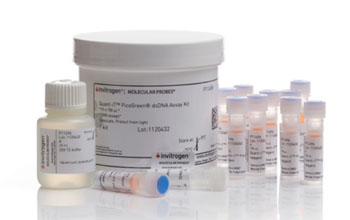Blood Test Provides Rapid Method of Detecting Solid Cancers
By LabMedica International staff writers
Posted on 22 Apr 2014
Circulating tumor DNA (ctDNA) is a promising biomarker for noninvasive assessment of cancer burden, but existing detection methods have insufficient sensitivity or patient coverage for broad clinical applicability.Posted on 22 Apr 2014
A new test has been developed that can quickly and noninvasively monitor the tiny concentrations of cancer cell DNA and this will be useful to clinicians who need to estimate the size of the tumor, how it changes over time, and monitor a patient's response to treatment.

Image: The Quant-iT PicoGreen dsDNA Assay Kit (Photo courtesy of Invitrogen).
Scientists at Stanford University (Stanford, CA, USA) found a way to improve on existing methods for extracting, processing and analyzing DNA. They called their approach CAPP-Seq, which is short for Cancer Personalized Profiling by deep Sequencing. CAPP-Seq combines optimized library preparation methods for low DNA input masses with a multiphase bioinformatics approach to design a “selector” consisting of biotinylated DNA oligonucleotides that target recurrently mutated regions in the cancer of interest. The investigators examined the genome of the 407 patients with non-small-cell lung cancer recruited for the study.
Matched tumor DNA was isolated from formalin-fixed, paraffin-embedded specimens or from the cell pellet of pleural effusions. Genomic DNA was quantified by Quant-iT PicoGreen dsDNA Assay Kit (Invitrogen; Carlsbad, CA, USA). The concentration of purified plasma DNA was determined by quantitative polymerase chain reaction (qPCR) using a HT7900 Real Time PCR machine (Applied Biosystems; Foster City, CA, USA).
The team tested blood from patients with non-small-cell lung cancer which includes most lung cancers, like adenocarcinomas, squamous cell carcinoma and large cell carcinoma. CAPP-Seq was sensitive enough to detect one molecule of tumor DNA among 10,000 DNA molecules from healthy cells in the blood. They identified 139 genes that only represent 0.004% of the human genome, but are recurrently mutated in non-small-cell lung cancer.
The investigators were able to compile a fingerprint for each cancer type made up of all the DNA mutations recorded and these include insertions or deletions of short pieces of genetic material, plus where sequences of DNA have been shuffled around or even flipped over. While no patient will have all these mutations, nearly all of them will have at least one of them. This makes it possible to compile a test that looks for as many of the known mutations for a given cancer as possible, but it only has to find one of them to strike a positive.
Maximilian Diehn, MD, PhD, co-senior author of the study, said “By sequencing only those regions of the genome that are highly enriched for cancer mutations, we're able to keep costs down and identify multiple mutations per patient. It's also possible we could use CAPP-Seq to identify subsets of early stage patients who could benefit most from additional treatment after surgery or radiation, such as chemotherapy or immunotherapy.” The study was published on April 6, 2014, in the journal Nature Medicine.
Related Links:
Stanford University
Invitrogen
Applied Biosystems














